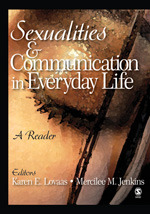Sexualities and Communication in Everyday Life
no information available
There are more than twenty-five contributors tthe Reader The sheer pleasure that the contributors provide in the way they bring together brilliantly diverse perspectives tenlarge the limits of ones understanding is not easy tdescribe Particularly stimulating among the collection are the pieces by Jeffrey Weeks and Patrick Johnson The intellectual satisfaction derived from the study of the erotic self and the human struggle and search for meaning and means of communicating meaning is quare indeed A book tread and return from time ttimeùThe Book ReviewôThis groundbreaking reader will spark the development of new courses in communication and sexualityá Students and teachers wanting tfully understand the constitutive and performative nature of communication will find few other books that meet their needs better than this oneöáùR Jeffrey Ringer, St Cloud UniversityááôSexualities and Communication in Everyday Life provides readers with a useful typology for comprehending the various shifts in thinking about sexual identities and communication that have occurred across time while it alsprovides a deft synthesis of the major issues and themesá The text puts an excellent breadth of essays--some newly acquired for this book, some previously published and germinalùeasily intstudentsÆ and teachersÆ handsö ùLesa Lockford, Bowling Green State Universityáá Sexualities and Communication in Everyday Life: A Reader is a groundbreaking anthology on the role of communication in the construction and performance of sexualities in interpersonal contexts and in public discourses Editors Karen E Lovaas and Mercilee M Jenkins bring together an interdisciplinary collection which include excerpts from foundational works, recent journal articles, and original pieces written specifically for this textááKey Features:áThis collection (1) assists students in understanding the intersections of sexuality with other identity constructions; (2) introduces the concepts and implications of queer theory; (3) challenges students tmove beyond stereotypical, dichotomous views of homosexual and heterosexual identities and communication styles; and, (4) facilitates studentsÆ awareness of and ability trecognize heteronormativity While most of the readings are written by communication researchers, there are many by scholars from various disciplines including sociology, English, psychology, gender studies, and anthropology These works alsexemplify a variety of research methods, with an emphasis on qualitative research including critical, ethnographic, and performance An introductory chapter providing a thorough review of literature tdate on communication and sexualities is followed by sections on interpersonal contexts and public discourses There is a logical flow from the foundational materials, tthe examinations of sexuality in oneÆs everyday vocabulary, interactions, and relationships, twider social discourses, tinterventions, praxis, and future visions In addition, discussion questions follow each reading tspark personal reflection and application ... Read more Read less











